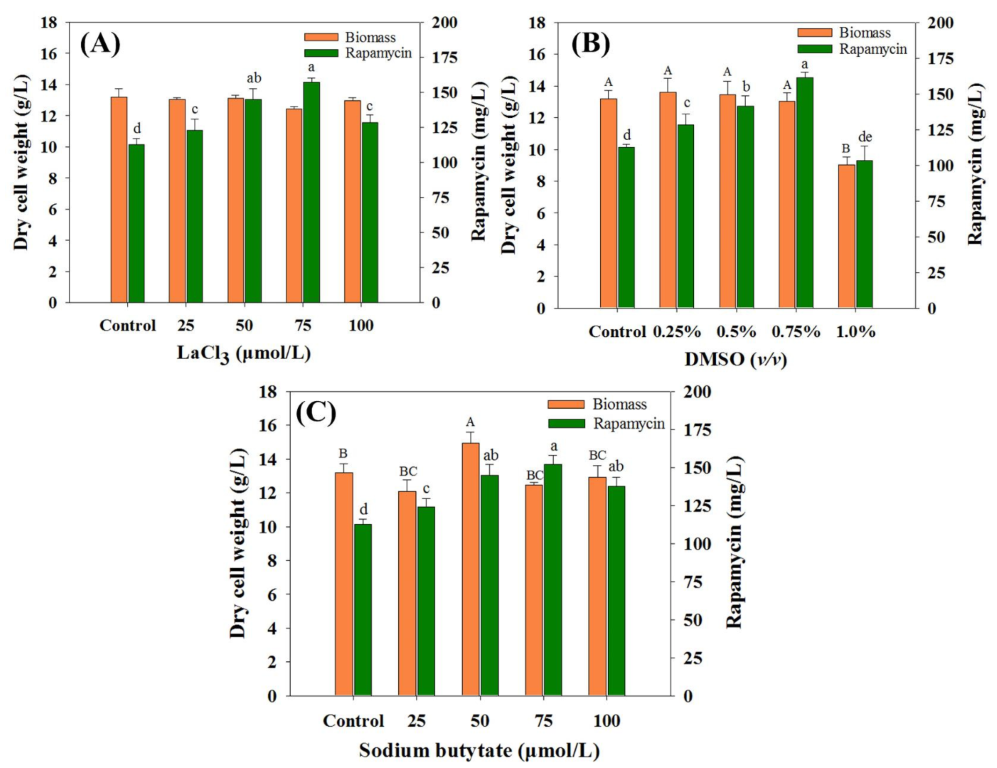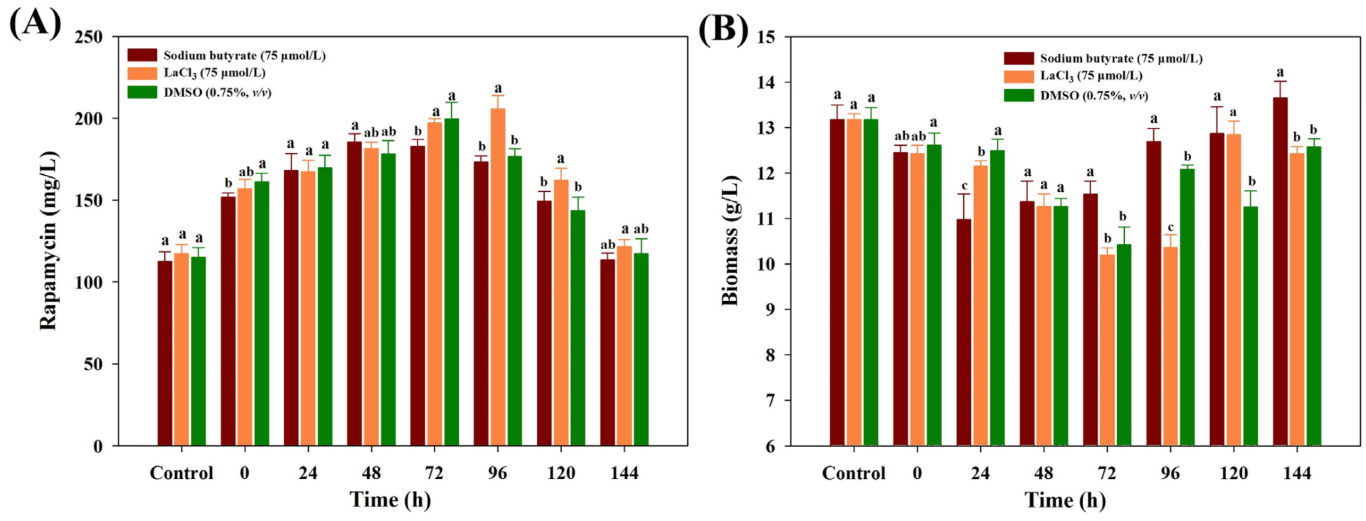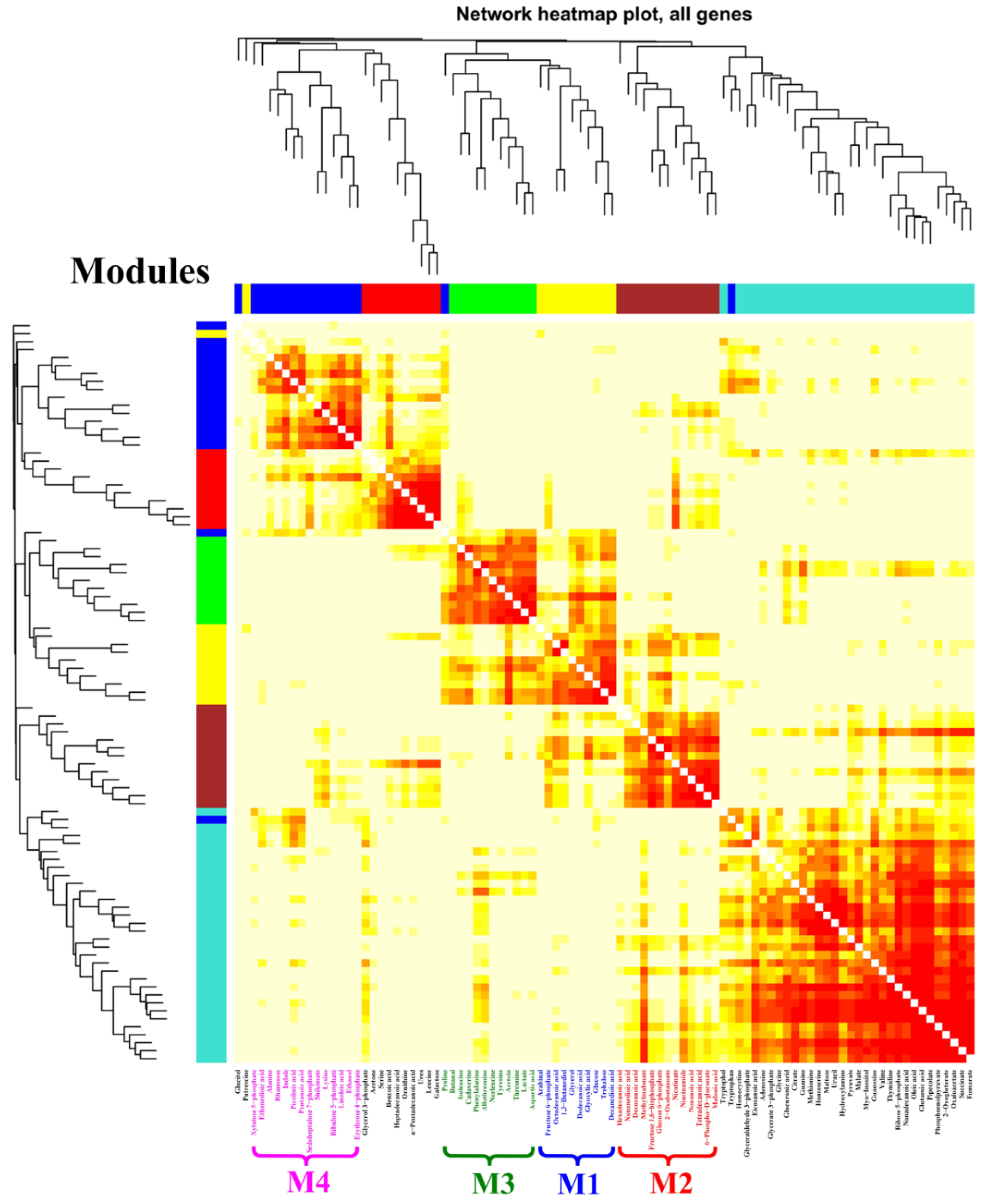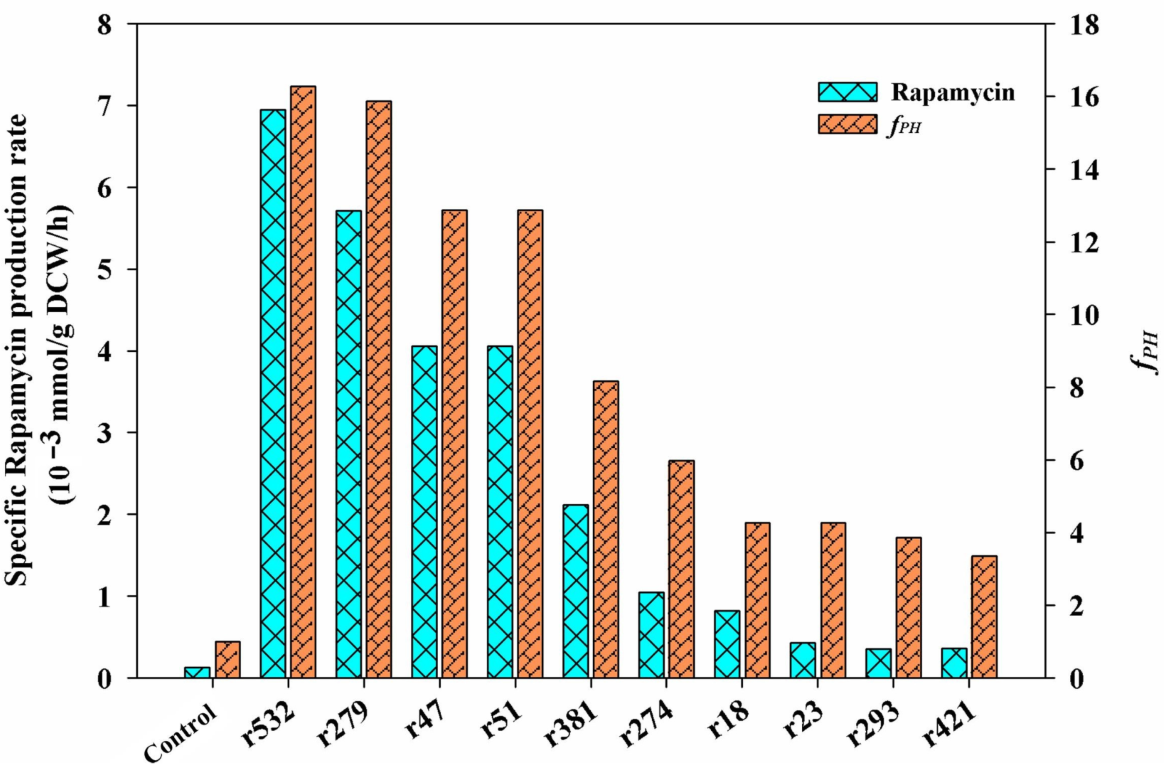Integrated Metabolomic and Network Analysis to Explore the Potential Mechanism of Three Chemical Elicitors in Rapamycin Overproduction
Abstract
1. Introduction
2. Materials and Methods
2.1. Strains and Cultivation
2.2. Chemicals
2.3. Manipulation of the Genes Deletion or Overexpression
2.4. Detection of the Basic Fermentation Parameters
2.5. Intercellular Metabolites Analysis
2.6. Screening of the Potential Key Genes by GSMM Model
2.7. Data Processing and Multivariate Statistical Analysis
3. Results
3.1. Effects of Different Chemical Elicitors on Rapamycin Accumulation
3.2. Metabolomic Profiles of Different Chemical Elicitor Treatments
3.3. Module Characteristics of the Intracellular Metabolism of Each Chemical Elicitor Treatment
3.4. Identification of the Key Limiting Steps using GSMM Analysis
3.5. Modification of the Potential Targets to Improve Rapamycin Production
4. Discussion
Supplementary Materials
Author Contributions
Funding
Institutional Review Board Statement
Informed Consent Statement
Data Availability Statement
Conflicts of Interest
References
- Yoo, Y.J.; Kim, H.; Park, S.R.; Yoon, Y.J. An overview of rapamycin: From discovery to future perspectives. J. Ind. Microbiol. Biotechnol. 2016, 44, 1–17. [Google Scholar] [CrossRef] [PubMed]
- Vézina, C.; Kudelski, A.; Sehgal, S.N. Rapamycin (AY-22.;989).; a new antifungal antibiotic. I. Taxonomy of the producing streptomycete and isolation of the active principle. J. Antibiot. 1975, 28, 21–26. [Google Scholar] [CrossRef] [PubMed]
- Houchens, D.P.; Ovejera, A.A.; Riblet, S.M.; Slagel, D.E. Human brain tumor xenografts in nude mice as a chemotherapy model. Eur. J. Cancer Clin. Oncol. 1983, 19, 799–805. [Google Scholar] [CrossRef]
- Malagelada, C.; Jin, Z.H.; Jackson-Lewis, V.; Przedborski, S.; Greene, L.A. Rapamycin Protects against Neuron Death in In Vitro and In Vivo Models of Parkinson’s Disease. J. Neurosci. 2010, 30, 1166–1175. [Google Scholar] [CrossRef]
- Harrison, D.E.; Strong, R.; Sharp, Z.D.; Nelson, J.F.; Astle, C.M.; Flurkey, K.; Nadon, N.L.; Wilkinson, J.E.; Frenkel, K.; Carter, C.S. Rapamycin fed late in life extends lifespan in genetically heterogeneous mice. Nature 2009, 460, 392–395. [Google Scholar] [CrossRef] [PubMed]
- Dutta, S.; Dey, A. Rapamycin Overproduction by Combined Mutational Study. Curr. Biochem. Eng. 2020, 6, 62–67. [Google Scholar] [CrossRef]
- Jung, W.S.; Yoo, Y.J.; Park, J.W.; Park, S.R.; Han, A.R.; Ban, Y.H.; Kim, E.J.; Kim, E.; Yoon, Y.J. A combined approach of classical mutagenesis and rational metabolic engineering improves rapamycin biosynthesis and provides insights into methylmalonyl-CoA precursor supply pathway in Streptomyces hygroscopicus ATCC 29253. Appl. Microbiol. Biotechnol. 2011, 91, 1389–1397. [Google Scholar] [CrossRef] [PubMed]
- Wang, B.; Liu, J.; Liu, H.; Huang, D.; Wen, J. Comparative metabolic profiling reveals the key role of amino acids metabolism in the rapamycin overproduction by Streptomyces hygroscopicus. J. Ind. Microbiol. Biotechnol. 2015, 42, 949–963. [Google Scholar] [CrossRef] [PubMed]
- Zhu, X.; Wei, Z.; Chen, X.; Wu, H.; Duan, Y.; Xu, Z. Generation of high rapamycin producing strain via rational metabolic pathway-based mutagenesis and further titer improvement with fed-batch bioprocess optimization. Biotechnol. Bioeng. 2010, 107, 506–515. [Google Scholar] [CrossRef] [PubMed]
- Dutta, S.; Basak, B.; Bhunia, B.; Sinha, A.; Dey, A. Approaches towards the enhanced production of Rapamycin by Streptomyces hygroscopicus MTCC 4003 through mutagenesis and optimization of process parameters by Taguchi orthogonal array methodology. World J. Microbiol. Biotechnol. 2017, 33, 90. [Google Scholar] [CrossRef]
- Yen, H.W.; Hsiao, H.P.; Chen, L.J. The enhancement of rapamycin production using Streptomyces hygroscopicus through a simple pH-shifted control. J. Taiwan Inst. Chem. Eng. 2013, 44, 743–747. [Google Scholar] [CrossRef]
- Dang, L.; Liu, J.; Wang, C.; Liu, H.; Wen, J. Enhancement of rapamycin production by metabolic engineering in Streptomyces hygroscopicus based on genome-scale metabolic model. J. Ind. Microbiol. Biotechnol. 2017, 44, 259–270. [Google Scholar] [CrossRef] [PubMed]
- Geng, H.; Liu, H.; Liu, J.; Wang, C.; Wen, J. Insights into the metabolic mechanism of rapamycin overproduction in the shikimate-resistant Streptomyces hygroscopicus strain UV-II using comparative metabolomics. World J. Microbiol. Biotechnol. 2017, 33, 1–13. [Google Scholar] [CrossRef] [PubMed]
- Zou, X.; Li, J. Precursor engineering and cell physiological regulation for high level rapamycin production by Streptomyces hygroscopicus. Ann. Microbiol. 2013, 63, 1371–1378. [Google Scholar] [CrossRef]
- Zhang, Y.; Chen, H.; Wang, P.; Wen, J. Identification of the regulon FkbN for ascomycin biosynthesis and its interspecies conservation analysis as LAL family regulator. Biochem. Eng. J. 2019, 151, 107349. [Google Scholar] [CrossRef]
- Yoon, V.; Nodwell, J.R. Activating secondary metabolism with stress and chemicals. J. Ind. Microbiol. Biotechnol. 2014, 41, 415–424. [Google Scholar] [CrossRef]
- Wang, C.; Huang, D.; Liang, S. Identification and metabolomic analysis of chemical elicitors for tacrolimus accumulation in Streptomyces tsukubaensis. Appl. Microbiol. Biotechnol. 2018, 102, 7541–7553. [Google Scholar] [CrossRef]
- Wang, C.; Wang, J.; Yuan, J.; Jiang, L.; Jiang, X.; Yang, B.; Zhao, G.; Liu, B.; Huang, D. Generation of Streptomyces hygroscopicus cell factories with enhanced ascomycin production by combined elicitation and pathway-engineering strategies. Biotechnol. Bioeng. 2019, 116, 3382–3395. [Google Scholar] [CrossRef]
- Ordóñez-Robles, M.; Santos-Beneit, F.; Albillos, S.M.; Liras, P.; Martín, J.F.; Rodríguez-García, A. Streptomyces tsukubaensis as a new model for carbon repression: Transcriptomic response to tacrolimus repressing carbon sources. Appl. Microbiol. Biotechnol. 2017, 101, 8181–8195. [Google Scholar] [CrossRef]
- Kol, S.; Merlo, M.E.; Scheltema, R.A.; de Vries, M.; Vonk, R.J.; Kikkert, N.A.; Dijkhuizen, L.; Breitling, R.; Takano, E. Metabolomic characterization of the salt stress response in Streptomyces coelicolor. Appl. Environ. Microbiol. 2010, 76, 2574–2581. [Google Scholar] [CrossRef]
- Wang, C.; Liu, J.; Liu, H.; Liang, S.; Wen, J. Combining metabolomics and network analysis to improve tacrolimus production in Streptomyces tsukubaensis using different exogenous feedings. J. Ind. Microbiol. Biotechnol. 2017, 44, 1527–1540. [Google Scholar] [CrossRef] [PubMed]
- Qi, H.; Lv, M.; Song, K.; Wen, J. Integration of parallel 13C-labeling experiments and in silico pathway analysis for enhanced production of ascomycin. Biotechnol. Bioeng. 2017, 114, 1036–1044. [Google Scholar] [CrossRef] [PubMed]
- Cheng, J.S.; Cui, S.F.; Ding, M.Z.; Yuan, Y.J. Insights into the roles of exogenous glutamate and proline in improving streptolydigin production of Streptomyces lydicus with metabolomic analysis. J. Ind. Microbiol. Biotechnol. 2013, 40, 1303–1314. [Google Scholar] [CrossRef] [PubMed]
- Cheng, J.S.; Liang, Y.Q.; Ding, M.Z.; Cui, S.F.; Lv, X.M.; Yuan, Y.J. Metabolic analysis reveals the amino acid responses of Streptomyces lydicus to pitching ratios during improving streptolydigin production. Appl. Microbiol. Biotechnol. 2013, 97, 5943–5954. [Google Scholar] [CrossRef] [PubMed]
- Sambrook, J.; Russel, D. Molecular Cloning: A Laboratory Manual, 3rd ed.; Cold Spring Harbor Laboratory Press: New York, NY, USA, 2001. [Google Scholar]
- Wang, C.; Liu, J.; Liu, H.; Wang, J.; Wen, J. A genome-scale dynamic flux balance analysis model of Streptomyces tsukubaensis NRRL18488 to predict the targets for increasing FK506 production. Biochem. Eng. J. 2017, 123, 45–56. [Google Scholar] [CrossRef]
- Huang, D.; Li, S.; Xia, M.; Wen, J.; Jia, X. Genome-scale metabolic network guided engineering of Streptomyces tsukubaensis for FK506 production improvement. Microb. Cell Fact. 2013, 12, 1–18. [Google Scholar] [CrossRef]
- Pei, G.; Chen, L.; Zhang, W. WGCNA application to proteomic and metabolomic data analysis. Methods Enzymol. 2017, 585, 135–158. [Google Scholar]
- Xia, J.; Wishart, D.S. MetPA: A web-based metabolomics tool for pathway analysis and visualization. Bioinformatics 2010, 26, 2342–2344. [Google Scholar] [CrossRef]
- Wang, J.; Liu, H.; Huang, D.; Jin, L.; Wang, C.; Wen, J. Comparative proteomic and metabolomic analysis of Streptomyces tsukubaensis reveals the metabolic mechanism of FK506 overproduction by feeding soybean oil. Appl. Microbiol. Biotechnol. 2017, 101, 2447–2465. [Google Scholar] [CrossRef]
- Butler, A.; Cundliffe, E. Influence of dimethylsulfoxide on tylosin production in Streptomyces fradiae. J. Ind. Microbiol. Biotechnol. 2001, 27, 6–51. [Google Scholar] [CrossRef]
- Chen, G.; Li, X.; Waters, B.; Davies, J. Enhanced production of microbial metabolites in the presence of dimethyl sulfoxide. J. Antibiot. 2020, 53, 145–1153. [Google Scholar] [CrossRef] [PubMed]
- David, N.A. The pharmacology of dimethyl sulfoxide. Annu. Rev. Pharmacol. 1972, 12, 353–374. [Google Scholar] [CrossRef] [PubMed]
- Yu, Z.W.; Quinn, P.J. Solvation effects of dimethyl sulphoxide on the structure of phospholipid bilayers. Biophys. Chem. 1998, 70, 35–39. [Google Scholar] [CrossRef]
- Shu, S.; Yuan, Y.; Chen, J.; Sun, J.; Zhang, W.; Tang, Y.; Zhong, M.; Guo, S. The role of putrescine in the regulation of proteins and fatty acids of thylakoid membranes under salt stress. Sci. Rep. 2015, 5, 1–16. [Google Scholar] [CrossRef]
- Turło, J.; Gajzlerska, W.; Klimaszewska, M.; Król, M.; Dawidowski, M.; Gutkowska, B. Enhancement of tacrolimus productivity in Streptomyces tsukubaensis by the use of novel precursors for biosynthesis. Enzyme Microb. Technol. 2012, 51, 388–395. [Google Scholar] [CrossRef]
- Zhu, H.; Sandiford, S.K.; van Wezel, G.P. Triggers and cues that activate antibiotic production by actinomycetes. J. Ind. Microbiol. Biotechnol. 2014, 41, 371–386. [Google Scholar] [CrossRef]
- Zhang, H.; Fan, W.; Zhang, Y.; Wang, W. Regulation of cellular permeability for improving blue pigment biosynthesis in Streptomyces coelicolor fermentation. Chin. J. Appl. Environ. Biol. 2002, 8, 540–543. [Google Scholar]
- Park, C.H.; Martinez, B.C. Enhanced release of rosmarinic acid from Coleus blumei permeabilized by dimethyl sulfoxide (DMSO) while preserving cell viability and growth. Biotechnol. Bioeng. 1992, 40, 459–464. [Google Scholar] [CrossRef]
- Kieser, T.; Bibb, M.J.; Buttner, M.J.; Chater, K.F.; Hopwood, D.A. Practical Streptomyces Genetics; John Innes Foundation: Bungay, UK, 2000. [Google Scholar]
- Wilkinson, C.J.; Hughes-Thomas, Z.A.; Martin, C.J.; Bohm, I.; Mironenko, T.; Deacon, M.; Wheatcroft, M.; Wirtz, G.; Staunton, J.; Leadlay, P.F. Increasing the efficiency of heterologous promoters in actinomycetes. J. Mol. Microbiol. Biotechnol. 2002, 4, 417–426. [Google Scholar]
- Xiang, S.H.; Li, J.; Yin, H.; Zheng, J.T.; Yang, X.; Wang, H.B.; Luo, J.L.; Bai, H.; Yang, K.Q. Application of a double-reporter-guided mutant selection method to improve clavulanic acid production in Streptomyces clavuligerus. Metab. Eng. 2009, 11, 310–318. [Google Scholar] [CrossRef]
- Bierman, M.; Logan, R.; O’Brien, K.; Seno, E.T.; Nagaraja, R.R.; Schoner, B.E. Plasmid cloning vectors for the conjugal transfer of DNA from Escherichia coli to Streptomyces spp. Gene 1992, 116, 43–49. [Google Scholar] [CrossRef]







| Module | Association | p Value | Metabolites |
|---|---|---|---|
| M1 | r = 0.79 | p = 3 × 10−4 | Trehalose, dodecanoic acid, decanedioic acid, glucose, glyoxylic acid, glycerol, fructose 6-phosphate, arabinal, 1,3-butanediol, octadecanoic acid, putrescine |
| M2 | r = 0.69 | p = 0.005 | Methylmalonate, nonanoic acid, niacinamide, 6-phospho-d-gluconate, docosanoic acid, hexadecanoic acid, fructose 1,6-bisphosphate, nonanedioic acid, nicotinate, tetradecanoic acid, glucose 6-phosphate, malonic acid, 2-oxobutanoate |
| M3 | r = 0.66 | p = 0.005 | Allothreonine, phenylalanine, tyrosine, aspartic acid, threonine, lactate, isoleucine, cadaverine, norleucine, acetoin, butanal |
| M4 | r = 0.81 | p = 1 × 10−4 | Proline, shikimate, glucitol, lysine, indole, xylulose 5-phosphate, tryptophan, rhamnose, picolinic acid, pentanoic acid, linoleic acid, ribulose 5-phosphate, sedoheptulose 7-phosphate, ethanol, erythrose 4-phosphate, ethanedioic acid, alanine |
| Reaction ID | Enzyme | Strategy | Reaction Definition |
|---|---|---|---|
| r532 | 2-dehydro-3-deoxyphosphoheptonate aldolase | Overexpression | Phosphoenolpyruvate + D-erythrose-4-phosphate + H2O → 3-deoxy-D-arabino-heptulosonate-7-phosphate + phosphate |
| r279 | Glutamate dehydrogenase (NADP+) | Knockout | NH3 + 2-oxoglutarate + NADPH + H → glutamate + NADP + H2O |
| r47 | Transketolase | Overexpression | Erythrose-4-phosphate + xylulose-5-phosphate → fructose-6-phosphate + glyceraldehyde-3-phosphate |
| r51 | Glucose-6-phosphate 1-dehydrogenase | Overexpression | D-glucose-6-phosphate + NADP → D-6-phosphogluconolactone + NADPH + H |
| r381 | Glutaryl-CoA dehydrogenase | Knockout | Glutaryl-CoA + (2) NAD → crotonyl-CoA + (2) NADH + CO2 |
| r274 | Aspartate aminotransferase | Overexpression | Oxaloacetate + L-glutamate → L-aspartate + alpha-ketoglutarate |
| r18 | Phosphoenolpyruvate carboxylase | Knockout | Phosphoenolpyruvate + CO2 + H2O → phosphate + oxaloacetate |
| r23 | Pyruvate carboxylase | Knockout | HCO3 + pyruvate + ATP → phosphate + oxaloacetate + ADP |
| r293 | Dihydrodipicolinate synthase | Overexpression | Pyruvate + L-aspartate-semialdehyde → (2) H2O + L-2,3-dihydrodipicolinate |
| r421 | Aspartate kinase | Overexpression | Aspartate + ATP → aspartyl-4-phosphate + ADP |
Publisher’s Note: MDPI stays neutral with regard to jurisdictional claims in published maps and institutional affiliations. |
© 2022 by the authors. Licensee MDPI, Basel, Switzerland. This article is an open access article distributed under the terms and conditions of the Creative Commons Attribution (CC BY) license (https://creativecommons.org/licenses/by/4.0/).
Share and Cite
Zhang, D.; Chen, J.; Wang, Z.; Wang, C. Integrated Metabolomic and Network Analysis to Explore the Potential Mechanism of Three Chemical Elicitors in Rapamycin Overproduction. Microorganisms 2022, 10, 2205. https://doi.org/10.3390/microorganisms10112205
Zhang D, Chen J, Wang Z, Wang C. Integrated Metabolomic and Network Analysis to Explore the Potential Mechanism of Three Chemical Elicitors in Rapamycin Overproduction. Microorganisms. 2022; 10(11):2205. https://doi.org/10.3390/microorganisms10112205
Chicago/Turabian StyleZhang, Dandan, Jinyu Chen, Zihui Wang, and Cheng Wang. 2022. "Integrated Metabolomic and Network Analysis to Explore the Potential Mechanism of Three Chemical Elicitors in Rapamycin Overproduction" Microorganisms 10, no. 11: 2205. https://doi.org/10.3390/microorganisms10112205
APA StyleZhang, D., Chen, J., Wang, Z., & Wang, C. (2022). Integrated Metabolomic and Network Analysis to Explore the Potential Mechanism of Three Chemical Elicitors in Rapamycin Overproduction. Microorganisms, 10(11), 2205. https://doi.org/10.3390/microorganisms10112205





